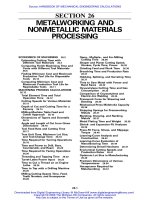Engineering Statistics Handbook Episode 4 Part 6 potx
Bạn đang xem bản rút gọn của tài liệu. Xem và tải ngay bản đầy đủ của tài liệu tại đây (100.09 KB, 21 trang )
2.6.1.1.1. Database of resistivity measurements
(10 of 15) [5/1/2006 10:13:12 AM]
2.6.1.1.1. Database of resistivity measurements
(11 of 15) [5/1/2006 10:13:12 AM]
2.6.1.1.1. Database of resistivity measurements
(12 of 15) [5/1/2006 10:13:12 AM]
2.6.1.1.1. Database of resistivity measurements
(13 of 15) [5/1/2006 10:13:12 AM]
2.6.1.1.1. Database of resistivity measurements
(14 of 15) [5/1/2006 10:13:12 AM]
2.6.1.1.1. Database of resistivity measurements
(15 of 15) [5/1/2006 10:13:12 AM]
Pooled level-1 standard deviations (ohm.cm)
Graphs of
reproducibility
and stability for
probe #2362
Averages of the 6 center measurements on each wafer are plotted on
a single graph for each wafer. The points (connected by lines) on the
left side of each graph are averages at the wafer center plotted over 5
days; the points on the right are the same measurements repeated
after one month as a check on the stability of the measurement
process. The plots show day-to-day variability as well as slight
variability from run-to-run.
Earlier work discounts long-term drift in the gauge as the cause of
these changes. A reasonable conclusion is that day-to-day and
run-to-run variations come from random fluctuations in the
measurement process.
Level-2
(reproducibility)
standard
deviations
computed from
day averages
and pooled over
wafers and runs
Level-2 standard deviations (with K - 1 = 5 degrees of freedom
each) are computed from the daily averages that are recorded in the
database. Then the level-2 standard deviations are pooled over:
L = 2 runs for L(K - 1) = 10 degrees of freedom
●
Q = 5 wafers for QL(K - 1) = 50 degrees of freedom●
as shown in the table below. The table shows that the level-2
standard deviations are consistent over wafers and runs.
2.6.1.2. Analysis and interpretation
(2 of 6) [5/1/2006 10:13:13 AM]
Level-2 standard deviations (ohm.cm) for 5 wafers
Level-3
(stability)
standard
deviations
computed
from run
averages
and pooled
over wafers
Level-3 standard deviations are computed from the averages of the two
runs. Then the level-3 standard deviations are pooled over the five
wafers to obtain a standard deviation with 5 degrees of freedom as
shown in the table below.
2.6.1.2. Analysis and interpretation
(3 of 6) [5/1/2006 10:13:13 AM]
Level-3 standard deviations (ohm.cm) for 5 wafers
Graphs of
probe
biases
A graphical analysis shows the relative biases among the 5 probes. For each
wafer, differences from the wafer average by probe are plotted versus wafer
number. The graphs verify that probe #2362 (coded as 5) is biased low
relative to the other probes. The bias shows up more strongly after the
probes have been in use (run 2).
2.6.1.2. Analysis and interpretation
(4 of 6) [5/1/2006 10:13:13 AM]
Formulas
for
computation
of biases for
probe
#2362
Biases by probe are shown in the following table.
Differences from the mean for each wafer
2.6.1.2. Analysis and interpretation
(5 of 6) [5/1/2006 10:13:13 AM]
How to deal
with bias
due to the
probe
Probe #2362 was chosen for the certification process because of its
superior precision, but its bias relative to the other probes creates a
problem. There are two possibilities for handling this problem:
Correct all measurements made with probe #2362 to the average
of the probes.
1.
Include the standard deviation for the difference among probes in
the uncertainty budget.
2.
The better choice is (1) if we can assume that the probes in the study
represent a random sample of probes of this type. This is particularly
true when the unit (resistivity) is defined by a test method.
2.6.1.2. Analysis and interpretation
(6 of 6) [5/1/2006 10:13:13 AM]
Run 2 -
Graph of
repeatability
standard
deviations
for probe
#2362 6
days and 5
wafers
showing
that
repeatability
is constant
across
wafers and
days
2.6.1.3. Repeatability standard deviations
(2 of 4) [5/1/2006 10:13:14 AM]
Run 1 -
Graph
showing
repeatability
standard
deviations
for five
probes as a
function of
wafers and
probes
Symbols for codes: 1 = #1; 2 = #281; 3 = #283; 4 = #2062; 5 =
#2362
2.6.1.3. Repeatability standard deviations
(3 of 4) [5/1/2006 10:13:14 AM]
Run 2 -
Graph
showing
repeatability
standard
deviations
for 5 probes
as a
function of
wafers and
probes
Symbols for probes: 1 = #1; 2 = #281; 3 = #283; 4 = #2062; 5 =
#2362
2.6.1.3. Repeatability standard deviations
(4 of 4) [5/1/2006 10:13:14 AM]
Wafer 139
Wafer 140
2.6.1.4. Effects of days and long-term stability
(2 of 5) [5/1/2006 10:13:15 AM]
Wafer 141
2.6.1.4. Effects of days and long-term stability
(3 of 5) [5/1/2006 10:13:15 AM]
Wafer 142
2.6.1.4. Effects of days and long-term stability
(4 of 5) [5/1/2006 10:13:15 AM]
2.6.1.4. Effects of days and long-term stability
(5 of 5) [5/1/2006 10:13:15 AM]
Run 2 -
Graph of
differences
from
wafer
averages
for each of
5 probes
showing
that probe
#2362
continues
to be
biased low
relative to
the other
probes
Symbols for probes: 1 = #1; 2 = #281; 3 = #283; 4 = #2062; 5 =
#2362
2.6.1.5. Differences among 5 probes
(2 of 2) [5/1/2006 10:13:15 AM]
2. Measurement Process Characterization
2.6. Case studies
2.6.1. Gauge study of resistivity probes
2.6.1.6.Run gauge study example using
Dataplot
View of
Dataplot
macros for
this case
study
This page allows you to repeat the analysis outlined in the case study
description on the previous page using Dataplot . It is required that you
have already downloaded and installed Dataplot and configured your
browser. to run Dataplot. Output from each analysis step below will be
displayed in one or more of the Dataplot windows. The four main
windows are the Output Window, the Graphics window, the Command
History window, and the data sheet window. Across the top of the main
windows there are menus for executing Dataplot commands. Across the
bottom is a command entry window where commands can be typed in.
Data Analysis Steps Results and Conclusions
Click on the links below to start Dataplot and
run this case study yourself. Each step may use
results from previous steps, so please be patient.
Wait until the software verifies that the current
step is complete before clicking on the next step.
The links in this column will connect you with
more detailed information about each analysis
step from the case study description.
Graphical analyses of variability Graphs to
test for:
Wafer/day effect on repeatability (run 1)1.
Wafer/day effect on repeatability (run 2)2.
Probe effect on repeatability (run 1)3.
Probe effect on repeatability (run 2)4.
Reproducibility and stability5.
1. and 2. Interpretation: The plots verify that, for
both runs, the repeatability of probe #2362 is not
dependent on wafers or days, although the
standard deviations on days D, E, and F of run 2
are larger in some instances than for the other
days.
3. and 4. Interpretation: Probe #2362 appears as
#5 in the plots which show that, for both runs,
the precision of this probe is better than for the
other probes.
2.6.1.6. Run gauge study example using Dataplot™
(1 of 2) [5/1/2006 10:13:16 AM]









